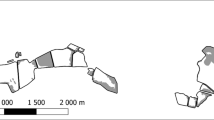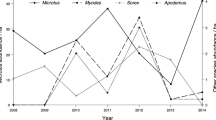Abstract
In generalist predators the energy needed for reproduction is derived from various prey categories, the profitability of which may vary according to the biomass or accessibility of the prey items. We examined the relationships between the diet and production of young in two Tawny Owl (Strix aluco) populations in southern Finland. We found a positive correlation between the amount of remnants of different prey in samples of litter collected from the nest bottoms after breeding and the production of young. Three important prey categories in the diet of owls during the nestling period, i.e. Water Voles, Field Voles and thrush-sized birds, seemed to be significantly related to the number of fledglings. However, only thrush-sized birds showed a significant relationship to the number of fledglings when all prey variables were analysed together in one model. The total prey mass was the best predictor of owl brood size. There were no significant local differences between the effects of different prey categories on the production of Tawny Owl young. Our results, combined with some earlier findings, outline the relationship between food supply and the production of Tawny Owl young in southern Finland. With regards to the Tawny Owl this outline can be generalized to other areas with other kinds of food supply within the distribution range of the species. Similar outlines are probably applicable also to many other generalist predators.
Zusammenfassung
Nahrung und Reproduktion von Küsten- und Inlandspopulationen des Waldkauzes Strix aluco in SüdfinnlandBei generalistischen Beutegreifern setzt sich die für die Reproduktion aufgewendete Energie aus den verschiedenen Beutekategorien zusammen, die je nach Biomasse und Verfügbarkeit der Beutestücke variieren können. Wir untersuchten die Beziehung zwischen Nahrung und Jungenproduktion in zwei Waldkauzpopulationen in Südfinnland. Wir fanden eine positive Korrelation zwischen der Anzahl an Beuteresten in Proben aus der Neststreu nach der Brut und der Jungenproduktion der Käuze. Drei bedeutende Beutekategorien in der Nahrung der Käuze während der Nestlingszeit schienen signifikant mit der Anzahl an Flügglingen zusammenzuhängen: Schermäuse, Erdmäuse und drosselgroße Vögel. Lediglich drosselgroße Vögel zeigten jedoch eine signifikante Beziehung in der Kombination mit allen Beutekategorien. Die gesamte Beutemasse erklärte die Brutgröße der Käuze am besten. Es gab keine signifikanten räumlichen Unterschiede zwischen den Effekten verschiedener Beutekategorien auf die Jungenproduktion der Käuze. In Kombination mit einigen früheren Ergebnissen liefern unsere Resultate einen Grundzusammenhang zwischen Nahrungsbereitstellung und der Produktion von jungen Waldkäuzen in Südfinnland. Innerhalb des Verbreitungsgebietes der Art kann dieser Grundzusammenhang generalisierend auf andere Gegenden mit anderen Arten der Nahrungsbereitstellung angewendet werden. Ähnliche Zusammenhänge sind außerdem vermutlich auch auf viele andere generalistischen Beutegreifer anwendbar.



Similar content being viewed by others
References
Angelstam P, Lindström E, Widén P (1984) Role of predation in short-term population fluctuations of some birds and mammals in Fennoscandia. Oecologia 62:199–208
Balčiauskienė L, Juškaitis R, Atkočaitis O (2005) The diet of the Tawny Owl (Strix aluco) in south-western Lithuania during the breeding period. Acta Zool Lituanica 15:13–20
Baudvin H, Jouaire S (2003) Breeding biology of the Tawny Owl Strix aluco in the forests of Burgundy. Vogelwelt 124:289–294
Brommer JE, Pietiäinen H, Kolunen H (2002) Reproduction and survival in a variable environment: Ural owl (Strix uralensis) and the three-year vole cycle. Auk 119:544–550
Brommer JE, Pietiäinen H, Ahola K, Karell P, Karstinen T, Kolunen H (2009) The return of the vole cycle refutes the generality of the loss of cycles through ‘climate forcing’. Global Change Biol 16:577–586
Charter M, Izhaki I, Leshem Y, Meyrom K, Roulin A (2015) Relationship between diet and reproductive success in the Israeli barn owl. J Arid Environ 122:59–63
Drent RH, Daan S (1980) The prudent parent: energetic adjustments in avian breeding. Ardea 68:225–252
Hakkarainen H, Koivunen V, Korpimäki E (1997) Reproductive success and parental effort of Tengmalm’s owls: effects of spatial and temporal variation in habitat quality. Ecoscience 4:35–42
Hämet-Ahti L (1981) The boreal zone and its biotic subdivision. Fennia 159:69–75
Jędrzejewski W, Jędrzejewska B, Zub K, Ruprecht AL, Bystrowski C (1994) Resource use by Tawny Owls Strix aluco in relation to rodent fluctuations in Białowieża National Park, Poland. J Avian Biol 25:308–318
Kekkonen J, Kolunen H, Pietiäinen H, Karell P, Brommer JE (2008) Tawny owl reproduction and offspring sex ratios under variable food conditions. J Ornithol 149:59–66
Kersalo J, Pirinen P (2009) The climate of Finnish regions. Finnish Meteorological Institute, Helsinki
Kirk DA (1992) Diet changes in breeding Tawny Owls (Strix aluco). J Raptor Res 26:239–242
Korpimäki E, Hakkarainen H (1991) Fluctuating food supply affects the clutch size of Tengmalm’s owl independent of laying date. Oecologia 85:543–552
Korpimäki E, Hakkarainen H (2012) The boreal owl. Ecology, behaviour and conservation of a forest-dwelling predator. Cambridge University Press, Cambridge
Korpimäki E, Sulkava S (1987) Diet and breeding performance of Ural owls Strix uralensis under fluctuating food conditions. Ornis Fenn 64:57–66
Krebs JR, Erichsen JT, Webber MI, Charnov EL (1977) Optimal prey selection in the Great Tit (Parus major). Anim Behav 25:30–38
Lack D (1954) The natural regulation of animal numbers. Clarendon Press, Oxford
Lehikoinen A, Byholm P, Ranta E, Saurola P, Valkama J, Korpimäki E, Pietiäinen H, Henttonen H (2009) Reproduction of the common buzzard at its northern range margin under climatic change. Oikos 118:829–836
Lourenço R, Delgado MM, Campioni L, Korpimäki E, Penteriani V (2015) Evaluating the influence of diet-related variables on breeding performance and home range behaviour of a top predator. Popul Ecol 57:625–636
Lundberg A (1980) Vocalizations and courtship feeding of the Ural Owl Strix uralensis. Ornis Scand 11:65–70
MacArthur RH, Pianka ER (1966) On optimal use of a patchy environment. Am Nat 100:603–609
Marchesi L, Sergio F, Pedrini P (2006) Implications of temporal changes in forest dynamics on density, nest-site selection, diet and productivity of Tawny Owls Strix aluco in the Alps. Bird Study 53:310–318
Martin TE (1987) Food as a limit on breeding birds: a life- history perspective. Annu Rev Ecol Systemat 18:453–487
Meijer T, Masman D, Daan S (1989) Energetics of reproduction in female kestrels. Auk 106:549–559
Meijer T, Daan S, Hall M (1990) Family planning in the kestrel (Falco tinnunculus): the proximate control of covariation of laying date and clutch size. Behaviour 114:117–136
Naef-Daenzer B, Keller LF (1999) The foraging performance of Great and Blue tits (Parus major and P. caeruleus) in relation to caterpillar development, and its consequences for nestling growth and fledging weight. J Anim Ecol 68:708–718
Newton I (1979) Population ecology of raptors. Poyser, Berkhamsted
Newton I (1980) The role of food in limiting bird numbers. Ardea 68:11–30
Newton I (1986) The Sparrowhawk. Poyser, London
Newton I (1998) Population limitation in birds. Academic Press, London
Nybo JO, Sonerud GA (1990) Seasonal changes in diet of hawk owls Surnia ulula: importance of snow cover. Ornis Fennica 67:45–51
Perrins CM, Moss D (1975) Reproductive rates in the great tit. J Anim Ecol 44:695–706
Petty SJ (1999) Diet of tawny owls (Strix aluco) in relation to field vole (Microtus agrestis) abundance in a conifer forest in northern England. J Zool 248:451–465
Pietiäinen H, Kolunen H (1993) Female body condition and breeding of the Ural owl Strix uralensis. Funct Ecol 7:726–735
R Development Core Team (2013) R: a language and environment for statistical computing. R Foundation for Statistical Computing, Vienna. URL: http://www.R-project.org
Ranazzi L, Manganaro A, Salvati L (2000) The breeding success of Tawny Owls (Strix aluco) in a Mediterranean area: a long-term study in urban Rome. J Raptor Res 34:322–326
Ricklefs RE (1974) Energetics of reproduction in birds. In: Paynter RA Jr (ed) Avian energetics. Nuttall Ornithological Club, Cambridge, pp 152–292
Roulin A, Ducret B, Ravussin PA, Altwegg R (2003) Female colour polymorphism covaries with reproductive strategies in the tawny owl Strix aluco. J Avian Biol 34:393–401
Sasvári L, Hegyi Z (2002) Effects of age composition of pairs and weather condition on the breeding performance of tawny owls, Strix aluco. Folia Zool 51:113–120
Saurola P (ed) (1995) Suomen pöllöt. Kirjayhtymä, Helsinki
Siivonen L, Sulkava S (2002) Pohjolan nisäkkäät. Otava, Hesinki
Solonen T (2005) Breeding of the tawny owl Strix aluco in Finland: responses of a southern colonist to the highly variable environment of the North. Ornis Fenn 82:97–106
Solonen T (2009) Factors affecting reproduction in the tawny owl Strix aluco in southern Finland. Ann Zool Fennici 46:302–310
Solonen T (2013) Factors affecting timing of breeding in the Tawny Owl Strix aluco. Open Ornithol J 6:40–51
Solonen T (2014) Timing of breeding in rural and urban Tawny Owls Strix aluco in southern Finland: effects of vole abundance and winter weather. J Ornithol 155:27–36
Solonen T, Ahola P (2010) Intrinsic and extrinsic factors in the dynamics of local small-mammal populations. Can J Zool 88:178–185
Solonen T, Karhunen J (2002) Effects of variable feeding conditions on the Tawny Owl Strix aluco near the northern limit of its range. Ornis Fenn 79:121–131
Solonen T, Ahola K, Karstinen T (2015) Clutch size of a vole-eating bird of prey as an indicator of vole abundance. Environ Monit Assess 187:1–9
Sonerud GA (1986) Effect of snow cover on seasonal changes in diet, habitat, and regional distribution of raptors that prey on small mammals in boreal zones of Fennoscandia. Holarct Ecol 9:33–47
Southern HN (1969) Prey taken by tawny owls during the breeding season. Ibis 111:293–299
van Veen JC, Kirk DA (2000) Dietary shifts and fledging success in breeding Tawny Owls Strix aluco. Ökol Vögel 22:237–281
Venables WN, Smith DM, the R Development Core Team (2014) An Introduction to R. Version 3.1.1. The R Project for Statistical Computing. R Foundation for Statistical Computing, Vienna. URL: http://www.r-project.org
von Haartman L, Hildén O, Linkola P, Suomalainen P, Tenovuo R (1963–1972) Pohjolan linnut värikuvin. Otava, Helsinki
Wendland V (1984) The influence of prey fluctuations on the breeding success of the Tawny Owl Strix aluco. Ibis 126:284–295
Zárybnická M, Sedláček O, Korpimäki E (2009) Do Tengmalm’s Owls alter parental feeding effort under varying conditions of main prey availability? J Ornithol 150:231–237
Żmihorski M, Balčiauskienė L, Romanowski J (2008) Small mammals in the diet of the Tawny Owl (Strix aluco L.) in Central European Lowland. Pol J Ecol 56:693–700
Acknowledgements
We warmly thank Kimmo af Ursin and Jari Pynnönen who helped us with the field work.
Author information
Authors and Affiliations
Corresponding author
Ethics declarations
The authors declare that they have no conflict of interest. All applicable institutional and/or national guidelines for the care and use of animals were followed.
Additional information
Communicated by O. Krüger.
Rights and permissions
About this article
Cite this article
Solonen, T., Karhunen, J., Kekkonen, J. et al. Diet and reproduction in coastal and inland populations of the Tawny Owl Strix aluco in southern Finland. J Ornithol 158, 541–548 (2017). https://doi.org/10.1007/s10336-016-1405-8
Received:
Revised:
Accepted:
Published:
Issue Date:
DOI: https://doi.org/10.1007/s10336-016-1405-8




